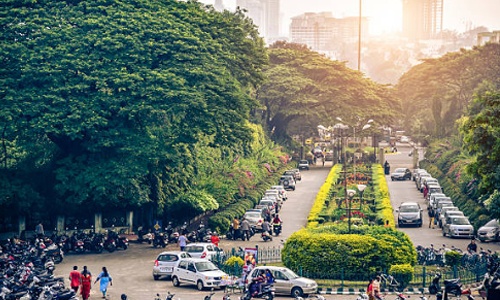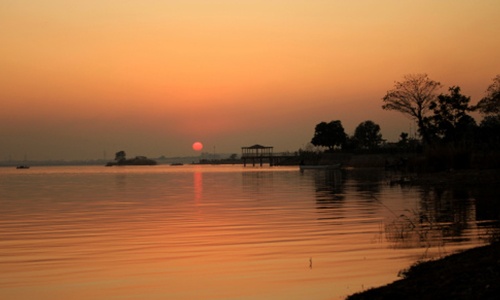
India and Pakistan
INDIA
According to the International Monetary Fund (IMF), the Indian economy is nominally worth US$1.758 trillion; it is the eleventh-largest economy by market exchange rates, and is, at US$4.962 trillion, the third-largest by purchasing power parity, or PPP. With its average annual GDP growth rate of 5.8% over the past two decades, and reaching 6.1%, India is one of the world’s fastest-growing economies. However, the country ranks 140th in the world in nominal GDP per capita and 129th in GDP per capita at PPP. Until recently, all Indian governments followed protectionist policies that were influenced by socialist economics. Widespread state intervention and regulation largely walled the economy off from the outside world. An acute balance of payments crisis forced the nation to liberalise its economy; since then it has slowly moved towards a free-market system by emphasising both foreign trade and direct investment inflows. India’s recent economic model is largely capitalist.

Bengaluru, India
Bangalore is the 3rd most populous city in India with a population of 8.4 million in the metropolitan area. Bangalore gained its nickname “Silicon Valley of India” for its role in for leading the revolution of IT outsourcing. Large IT players such as Infosys, Wipro, ISRO, Flipkart, Biocon, and HAL are all headquartered in the city and contribute to 33% of India’s IT exports. It also has a GDP of $83Billion, making it the 4th largest in India, behind Mumbai, Delhi and Kolkata. India is home to 57 Global 2000 companies. They are: Reliance Industries; ONGC; ICICI Bank; TCS; Bharti Airtel; Infosys; Wipro; Tata Steel; Mahindra and Mahindra; HCL and Adani Enterprises just to name a few.

Delhi, India
Delhi is the largest commercial centre in northern India; it has an estimated net State Domestic Product of 1578.17 billion (US$25 billion) in nominal terms and ~ 6300 billion (US$100 billion) in PPP terms. The per capita income of Delhi was Rs.210000, highest in India. GSDP in Delhi at the current prices is estimated at Rs 3.66 lakh crore. As per the Economic survey of Delhi, the tertiary sector contributes 70.95% of Delhi’s gross SDP followed by secondary and primary sectors, with 25.20% and 3.85% contributions respectively. Delhi’s workforce constitutes 32.82% of the population, and has increased by 52.52%. Key service industries are information technology, telecommunications, hotels, banking, media and tourism. Construction, power, health and community services, and real estate are also important to the city’s economy. Delhi has one of India’s largest and fastest growing retail industries. Manufacturing also grew considerably as consumer goods companies established manufacturing units and headquarters in the city. Delhi’s large consumer market and the availability of skilled labour has attracted foreign investment. The manufacturing sector employs 1,440,000 workers and the city had 129,000 industrial units.

Mumbai, India
Mumbai is India’s largest city (by population) and is the financial and commercial capital of the country as it generates 6.16% of the total GDP. It serves as an economic hub of India, contributing 10% of factory employment, 25% of industrial output, 33% of income tax collections, 60% of customs duty collections, 20% of central excise tax collections, 40% of India’s foreign trade and 4000 crore (US$640 million) in corporate taxes. Along with the rest of India, Mumbai has witnessed an economic boom since liberalisation. Mumbai’s GDP is 919600 crore (US$150 billion), and its per-capita (PPP) income is 486,000 (US$7,800), which is almost three times the national average. Its nominal per capita income is 125,000 (US$2,000), (US$2,094). Many of India’s numerous conglomerates (including Larsen and Toubro, State Bank of India (SBI), Life Insurance Corporation of India (LIC), Tata Group, Godrej and Reliance), and five of the Fortune Global 500 companies are based in Mumbai. This is facilitated by the presence of the Reserve Bank of India (RBI), the Bombay Stock Exchange (BSE), the National Stock Exchange of India (NSE), and financial sector regulators such as the Securities and Exchange Board of India (SEBI).
PAKISTAN
Pakistan is a rapidly developing country and is one of the Next Eleven, the eleven countries that, along with the BRICs, have a high potential to become the world’s largest economies in the 21st century. However, after decades of war and social instability, serious deficiencies in basic services such as railway transportation and electric power generation have developed. The economy is semi-industrialized, with centres of growth along the Indus River. The diversified economies of Karachi and Punjab’s urban centres coexist with less developed areas in other parts of the country. Pakistan’s estimated nominal GDP is US$202 billion. The GDP by PPP is US$488.6 billion. The estimated nominal per capita GDP is US$1,197, GDP (PPP) per capita is US$2,851 (international dollars), and debt-to-GDP ratio is 55.5%. A report by RAD-AID positioned Pakistan’s economy at 27th largest in the world by purchasing power and 45th largest in absolute dollars. It is South Asia’s second largest economy, representing about 15 percent of regional GDP.

Islamabad, Pakistan
Islamabad is a net contributor to the Pakistani economy, as whilst having only 0.8% of the country’s population, it contributes 1% to the country’s GDP. Islamabad Stock Exchange is Pakistan’s third largest stock exchange after Karachi Stock Exchange and Lahore Stock Exchange. The exchange has 118 members with 104 corporate bodies and 18 individual members. The average daily turnover of the stock exchange is over 1 million shares.Islamabad LTU (Large Tax Unit) was responsible for Rs 371 billion in tax revenue, which amounts to 20% of all the revenue collected by Federal Board of Revenue. Islamabad has seen an expansion in information and communications technology with the addition two Software Technology Parks, which house numerous national and foreign technological and information technology companies. The tech parks are located in Evacuee Trust Complex and Awami Markaz. Awami Markaz houses 36 IT companies while Evacuee Trust house 29 companies. Call centres for foreign companies have been targeted as another significant area of growth, with the government making efforts to reduce taxes by as much as 10% to encourage foreign investments in the information technology sector. Most of Pakistan’s state-owned companies like PIA, PTV, PTCL, OGDCL, and Zarai Taraqiati Bank Ltd. are based in Islamabad. Headquarters of all major telecommunication operators such as PTCL, Mobilink, Telenor, Ufone, and China Mobile are located in Islamabad.





